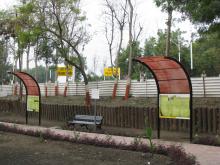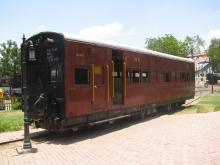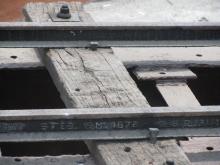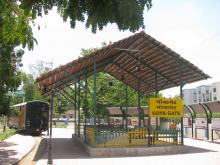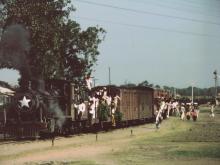It all started in early 1850s when Khanderao, the Maharaja of Vadodara built a line between Miyagam Karjan and Dabhoi. It was on 2’6” gauge with rails weighing 13 lbs to a yard. The line was designed and constructed by A.W.Forde. A pair of oxen used to haul trains composed of 4-6 vehicles. In 1863, Khanderao purchased 3 steam locomotives built by Neilson and Co., Glasgow. These 0-4-0 ST locomotives proved to be too heavy for the rails. During the reign of Malharrao in 1871, the old rails were removed and new rail 30 lbs to a yard were laid. The 32.3 km Miyagam-Dabhoi line was reopened for traffic on 8.4.1873. Today this is the oldest NG line in the world still in use for commercial traffic without any break in daily services.
When I visited the area in October, 2003, five lines branched out from Dabhoi. In the North the line branched to Timba road, in Northeast to Chhuchhapura, in Southeast to Chandod, in South to Pratapnagar and Southwest to Choranda. The total NG network in the Vadodara division was 696 kms.
Dabhoi- Chandod 17 kms
Dabhoi-Choranda junction 42kms
Choranda-Malsar 29kms
Choranda-Motikoral 18kms
Dabhoi-Jambusar junction 80 kms
Jambusar junction-Kavi 26kms
Jambusar junction-Samni junction 24 kms
Samni junction-Dahej 40 kms (Services were temporarily closed)
Samni junction-Bharuch 24 kms
Dabhoi-Chhuchapura junction 21 kms
Chhuchapura junction-Chota Udeipur 50kms
Chhuchapura junction-Tankhala 38kms
Dabhoi-Timba road 105 kms (Services were temporarily closed)
Nadiad-Bhadran 59 kms
Kosamba-Umarpada 61 kms
Ankleshwar-Rajpipla 62 kms
Total 696 kms
When I revisited the area again in October, 2011 the Dabhoi- Pratap Nagar and Dabhoi-Bodeli sections had been converted to Broad gauge. Except for the Pratap Nagar-Jambusar, Dabhoi- Chandod, Dabhoi-Miyagam, Nadiad –Bhadran and Kosamba-Umarpada section all other sections too were closed either for gauge conversion or for reasons best known to Railways!
However the rich heritage of the once extensive narrow gauge network has been well documented and preserved. Under the able stewardship of Mr. A. K. Srivastava, DRM, Vadodara division heritage parks have been established at Dabhoi and Pratap Nagar.
The Dabhoi heritage park is located next to the Dabhoi-Miyagam line. The park has 15 panels which display majesty of the Gaekwar’s, old grandeur of Dabhoi, coverage in Illustrated London News showing the bullock hauled trains, letters exchanged between the Resident and British government, Plans and sketches related to the narrow-gauge railway. The park is a pioneering effort in popularizing railway history by linking it with people and places where the railways evolved and attempts to weave an interesting story. Apart from using panels displayed on bent narrow gauge rails, the park also displays some original documents in a well-maintained room. Documents include contract entered by Gaekwar’s for construction of narrow-gauge railway, Agreements entered with BB&CI for operation and maintenance of the railway and some other important letters. For railway enthusiasts with interest in economics, some panels also give details about financial performance of the lines. It shows that how since its inception the Dabhoi lines were generating surplus and how in a very short period it was able to pay interest on capital also. Old time tables are also displayed in some panels.
Pratap Nagar (then known as Goya gate) was the place where NR Railway first came to Vadodara (then called Baroda) on 1st July, 1880. It was also the location for the first NG workshop established in 1919, the railway headquarters for Gaekwar’s railway and a colony built on the pattern of Tergnier in France established by Compagnie du Nord. The panels at the Pratap Nagar heritage shed display information about the first railway run in India, arrival of the first train in Baroda in 1861 and organization of the NG network over the years. A narrow-gauge coach SR 695 can be seen at the station modeled after the old Goya gate station. Enthusiasts can have tea and snacks inside a narrow-gauge coach converted into a dining car. The rolling stock park nearby has an old turn table built in 1874 by Ormerod Crierson & Co. Ltd, old narrow-gauge rails and NG rolling stock.
The NG museum nearby has also been given a facelift. Though inaugurated way back in 1958, it was in a very bad shape till it was revived by Mr. A. K. Srivastava. Besides displaying old photographs of the NG line and its locomotives, the museum also has information panels on Bollywood films and railways, Famous books with railway theme and Famous cartoon characters with railway connection.
The lines may have closed down but the memories remain!

